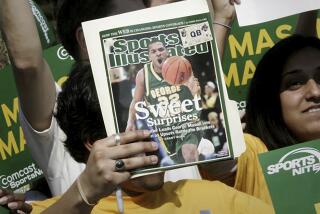75 years of Fortune telling
- Share via
The folks who put out Fortune magazine are geniuses. In 1949, they predicted that computers would create a “second industrial revolution.” In 1971, they forecast the rise of the VCR. In 1977, long before Prozac, they predicted the effect of mood-altering drugs. In 1980, they recognized that the Solidarity movement in Poland was “a truly epochal event -- an irreparable crack in the foundations of the communist order.”
The folks who put out Fortune are idiots. In 1934, they dismissed fascism as “essentially a local issue.” In 1939, they announced that it was “practically impossible for Roosevelt to be elected in 1940.” In 1961, they reported that American Protestantism was fading away. In 1974, they raised alarms about the threat of “global cooling.”
Obviously, the folks who put out Fortune have had their ups and downs over the last 75 years. But, as their fascinating new 75th anniversary special issue reminds us, they publish the best business magazine in America.
Fortune was conceived by Henry Luce, the magazine genius who had created Time six years earlier and who would create Life six years later. Fortune was born at the worst possible time for a big, glossy business mag -- 1930, the very depths of the worst depression in American history.
A memo Luce wrote back then reveals how little he understood the financial situation: “We will not be over-optimistic. We will recognize that this business slump may last as long as an entire year.”
Of course, the “slump” lasted longer than a decade, but Fortune managed to survive, partly because of Luce’s deep pockets and partly because of its impressive roster of talent. Over the years, it employed soon-to-be-famous writers James Agee, Archibald MacLeish, Dwight Macdonald and John Kenneth Galbraith and soon-to-be-famous photographers Walker Evans, Margaret Bourke-White and W. Eugene Smith.
In 1934, Fortune sent Agee and Evans to Alabama to produce a story on the plight of impoverished sharecroppers. As it turned out, Agee’s prose was far too poetic and personal to run in Fortune, but the collaboration, published as the book “Let Us Now Praise Famous Men,” became an American classic.
A couple of decades later, Fortune launched another American classic when staffer William H. Whyte turned his series on postwar corporate culture into a book called “The Organization Man.”
In this anniversary issue, Fortune recalls those triumphs but doesn’t dwell on them. Instead, the nostalgic pieces share space with Fortune’s usual array of excellent articles on contemporary topics. There’s a balanced piece on Thomas Friedman, the controversial New York Times columnist and bestselling globalization guru, and his many vociferous critics.
Even better is a piece called “The Law of Unintended Consequences.” It’s a convincing analysis of how the 1980 Bayh-Dole Act, designed to enable universities to profit from the scientific discoveries of their researchers, has ended up fostering secrecy, greed and lawsuits while impeding the flow of medical knowledge.
“Universities have evolved from public trusts into something closer to venture capital firms,” writes senior editor Clifton Leaf. “What used to be a scientific community of free and open debate now often seems like a litigious scrum of data-hoarding and suspicion.”
For magazine buffs, though, the best piece in this issue is Carol Loomis’ “My 51 Years (and Counting) at Fortune.”
Now 76, Loomis is one of the little-known heroes of journalism. A dogged investigative reporter -- she read 50 years of annual reports for a recent article on Bethlehem Steel -- Loomis specializes in holding the Gucci-clad feet of America’s chief executives to the fire.
The titles of her greatest hits give you an idea of her bite: “The Madness of Executive Compensation,” “AT&T; Has No Clothes,” “The $600 Million Cigarette Scam” and “Recipe for Jail,” a prescient pre-Enron 1999 piece on fraudulent corporate accounting that was illustrated by a cover photo of ledger books being cooked in a big stewpot.
More to Read
Sign up for our Book Club newsletter
Get the latest news, events and more from the Los Angeles Times Book Club, and help us get L.A. reading and talking.
You may occasionally receive promotional content from the Los Angeles Times.








